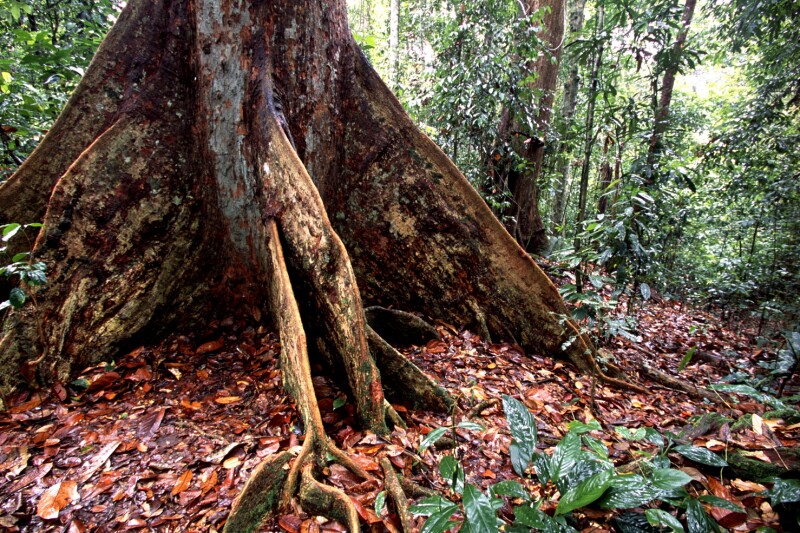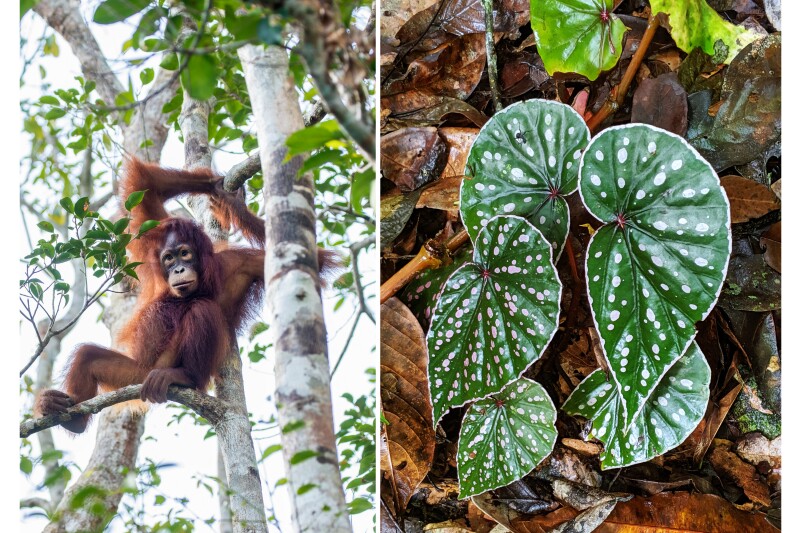A few years ago, I was researching jungle trips when I came across a photo that looked to me like pure adventure. It showed a young woman in hiking boots and utility shorts standing in a shallow creek, surrounded by rain forest. Her hair was in a loose braid, her hands grasped the straps of a canvas rucksack, and she gazed up in wonder at the greenery towering over her. I was sure she was about to slip between the tree trunks that stretched all the way out of the frame and enter a world of tangled vines that hid leeches, fanged mammals, and probably some ancient ruins. I looked up from my paper-covered desk at the office buildings blocking my view of the sky and decided I’d watched one too many adventure movies.
But still, when I started preparing for a nearly two-week trip through the wilds of Borneo with the travel company GeoEx, I envisioned myself quite literally in that woman’s shoes: I bought a pair of similar hiking boots, dug out my canvas backpack, and practiced my French braid.

Guests with GeoEx explore Deer Cave—the largest cave passage in the world—in Gunung Mulu National Park and spot many species of frog, snake, and spider on night hikes in the Danum Valley.
Photos by Maggie Fuller
My first day in a Bornean rain forest looked . . . nothing like that photograph. I was no fresh-faced figure in shorts, engulfed by thick, untamed undergrowth. No, I stood sweating in 90 percent humidity on a tidy boardwalk in Bako National Park, hoping that my neckerchief, long-sleeved shirt awkwardly tucked into hiking pants, and dorky cap would thwart mosquitoes.
And I didn’t feel much like an adventurer either. Sure, it was a delightful day: My travel companions and I came nose to bulbous nose with placid proboscis monkeys and found a delicate emerald-green pit viper curled around a branch. Our guide pointed out yards-long rattan palm fronds, which local craftspeople weave into mats and baskets, and introduced us to the tall ironwood and dipterocarp trees that anchor the rain forest canopy to the earth. But hand-painted signs continually reminded us to stay on the boardwalk. I was not to go crashing off into the jungle like some crazy lady Tarzan wannabe.
I get it. Borneo’s incredible biodiversity needs to be protected from the eager, bumbling feet of humans. And those same humans need to be protected from reticulated pythons, fire ants, poisonous centipedes, and the jungle’s many other dangers. So I understood why, over the next week, we mostly interacted with Borneo’s nature in a safe, controlled way.
In Gunung Mulu National Park, we followed sparsely lit, roped-off trails through some of the largest caves in the world, keeping our headlamps lowered out of respect for the colonies of wrinkle-lipped bats that hung from the ceilings. We flew 40 minutes to Sandakan, where we visited the Sepilok Orangutan Rehabilitation Centre and got our first look at the famous endangered apes. The lanky, semi-wild creatures swung languidly out of the jungle and onto feeding platforms about 10 yards from our viewing spot. And on dawn and evening cruises up the nearby Kinabatangan River we stayed in our boat, training binoculars and cameras on stork-billed kingfishers while listening for the rhinoceros hornbill’s weird call and the whoosh of its huge, powerful wings.

Buttressed roots provide stability to towering rain forest trees such as the banyans, ironwoods, and dipterocarps.
Courtesy of GeoEx
But I relished the moments when the divide was breached: when a band of scruffy long-tailed macaques descended screeching, with teeth bared, on a hapless tourist in front of us in Bako; when I floated in the chilly, mineral-rich water of a natural river that ran through Clearwater Cave in Gunung Mulu, under a complicated atrium of electric-green boughs; and the many, many times a bat swooped too close as I walked to and from dinner on the Kinabatangan River.
Our jungle journey ended at the Borneo Rainforest Lodge in the heart of the Danum Valley Conservation Area, one of Southeast Asia’s last strongholds of virtually undisturbed lowland rain forest. Here the trees stretch up as if racing each other to the canopy, breaking through the draping vines and lesser trees, out into the sunlight 200 to 300 feet above the forest floor. They grow so massive that on our two-and-a-half-hour drive to the lodge, the 4x4 vehicle in front of mine looked like a Matchbox car.
“Here,” I thought. “There’s adventure here.”
The jungle spilled over its boundaries—and not just the foliage. One afternoon, after watching a wild orangutan and her baby rustle the treetops over my villa, I nearly stepped on a tree snake no bigger than a shoelace as I made my way to the open-air common area; when I got there, I found a family of seven small, fuzzy red leaf monkeys sitting unperturbed on a railing.
On our second morning at the lodge, we hiked. Even with a guide, the route was treacherous. We clambered up a narrow, rain-slicked dirt trail and sidestepped down a steep, overgrown hill, clutching at rope handrails and stopping periodically to check for tiger leeches.
After two hours, we reached a waterfall. About 15 feet tall, the cascade rained cool, wispy spray down on us like confetti in a ticker-tape parade as we emerged from the bushes. I unshouldered my sweat-soaked backpack and stepped over to dip the toes of my boots in the water. I stood for a while looking up at the place where the falls spilled out onto the flat, mossy rock face, at the trees pushing skyward, and the small patch of blue directly above me. And I felt the jungle swallow me whole.

Critically endangered orangutans are only found in Borneo and Sumatra; at the Sepilok Orangutan Rehabilitation Centre, orphaned orangutans are rescued, nursed, and then released into the wild.
L: Courtesy of GeoEx; R: Photo by Maggie Fuller
How to do this trip
Associate editor Maggie Fuller traveled through Borneo with the luxury travel company GeoEx. The 13-day, small-group “Rivers and Jungles of Borneo” itinerary begins in Kuching, the capital of the Malaysian state of Sarawak. There, travelers get an introduction to the area’s history and people and take a boat trip to nearby Bako National Park to spot proboscis monkeys. Guests then travel by air to explore the caves of Gunung Mulu National Park, a UNESCO World Heritage site. From there, they fly to the state of Sabah to visit an orangutan rehabilitation center and to look for pygmy elephants and eight types of hornbills on wildlife cruises up the Kinabatangan River. The trip culminates in the Danum Valley Conservation Area, where, on jungle hikes, travelers may spot wild orangutans and reticulated pythons. From $8,945.
More Epic Trips From AFAR
- Why heli-hiking is the best way to see Canada’s pristine wilderness
- The Venice-Simplon-Orient-Express is a real-life time machine
- Antarctica for polar explorers who might not be so tough after all
- What we learned from the famously fearless creatures of the Galápagos
- This is the Kenya journey we all need to go on
- In New Zealand, you’ll always feel welcome
>> Next: 10 Things I’d Wish I’d Known Before Traveling to Borneo











